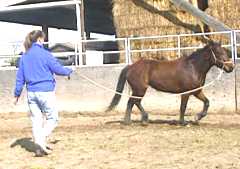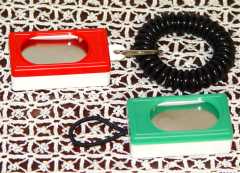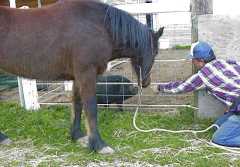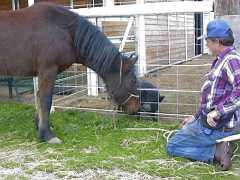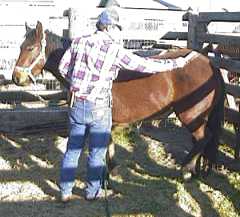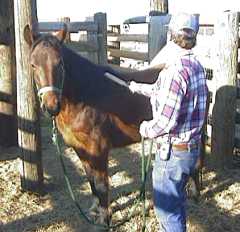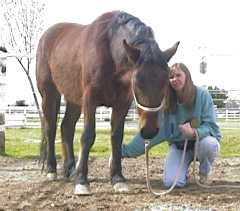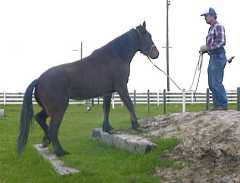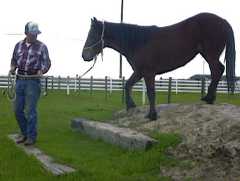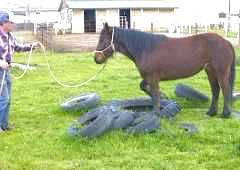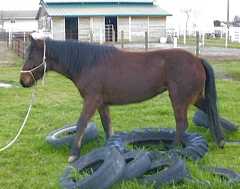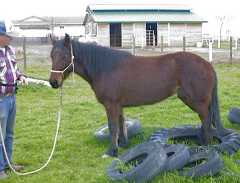|
Once the horse has learned the click-reward association,
it's time to organize some clicker games. The most important
elements include asking for behaviors that the horse can
easily accomplish and therefore will want to play, and the
handler has to be reasonably organized so he/she can fire off
a click the instant the horse accomplished the objective.
It's less important that the treat be immediately produced.
The handler has the ability to take time and safely provide
the treat reward.
You can choose any simple behavior that you wish. The first
behavior we teach is "Touch it!" It's a simple behavior
which the horse can grasp and also focuses the horse on a
specific target. "Touch it" is important later when we want
the horse to explore something fundamentally scary (such as
the horse vacuum, farrier tools, other animals, etc.) When
the horse is pushed into a stress-feedback loop, the
destructive behavior can be interrupted and his mind can be
brought to focus on something familiar.
"Touch it!" is also a behavior we use to get the horse to focus
on a target which will eventually touch the horse, such as the
horse vacuum or clippers and even the veterinarian's syringe. We ask the horse to "Touch it!" and after he does,
this a few times, we move the object to the horse while the horse
is following it curiously, not with fear, then we touch the horse
with the object.
Another game is "Stand still!" The objective is for the horse
to relax. In the beginning the horse is asked to stand still
for a click, then stand while the brush touches him, then stand
as the handler moves over his body. If the horse is too skittish,
we may rub the horse with a bamboo pole which allows a little
more distance and is less unsettling. Even with click reinforcement
the horse has his limits, so the art here is to make as much
progress as you can but don't cross over the line.
Too much pressure on the horse may start to trigger a stress-feedback
loop response in which case the horse can be refocused with "Touch it!"
After a few good touches to reestablish a response baseline, we will
again proceed with asking the horse to stand while different things
happen.
Next we will teach "Step up!" which we will also reinforce with
"Touch it!" Through "Step up!" the horse learns to move forward and
also learns to give to the pressure of the lead rope. When leading
a green horse, there is a likelihood that the horse will stall or
try to back up. "Step up!" is a behavior that will often help unlock
those feet and get the horse moving again. "Step up!" can also
be used to break a stress-feedback loop when the horse becomes
spooked at an object and we are too far away to play the "Touch
it!" game.
Once in the round pen we will start putting all of this stuff
together with our standard natural horsemanship program. For more
complex or worrisome behaviors we will use a combination of
clicker and "learn-Learn" approaches.
For example, I have a bad back and I won't fight with a horse to
trim his feet. I expect the horse, even a wild one, to pick up
his foot and rest it in my hand or across my leg so I can work.
Typically I'll start by handling the legs using "Stand still!"
Then I'll distinctively tap the back of the fetlocks and ask
"Pick up!" When the horse reflexively lifts his foot, he gets a
click. Pretty soon I'll have my hand positioned under the foot
and I'll want the horse to rest it there for increasing periods
of time before giving the click.
Within a few tries, the horse will usually hold his foot for a
minute or more and it's at that point I will start in with the
nippers. Before the horse gets anxious with the process, I'll
use some "Click reinforcement" (remind him of the behavior and
reinforce it with a click-reward) or have the horse target something
familiar.
On the horse course we use a combination of "Walk up!" and targeting
to keep the horse focused. A focused horse isn't nearly as likely
to get worked up over new things and lose mental contact with the
handler. If the object appears too scary at first, we "Touch it!"
When it's time to walk through or past it we will use "Walk up!"
with some light reinforcement on the lead rope. If the horse is
still overly wary, which is not often, we'll have him target something
familiar and reassuring.
The specific behaviors that you can use are not limited to the examples
we have illustrated here. You can use your imagination, but be
sensible, consistent and always construct the lesson so that the horse
can win. They like to be correct and winning (gaining human approval)
eventually becomes a motivator in itself. When expanding into the
frontier of new behaviors always have a reinforcement behavior handy,
such as a simple "Touch it!" so if the horse starts to become frustrated,
you can show him that he can still win the game and avoid a frustration
induced stress-feedback loop.
Finally, get organized and decide what you want to accomplish before you start the lesson,
but always work with the reality of the moment. Environmental conditions or the
horse's state of mind may make your primary objective difficult to
achieve, but another learning opportunity may present itself which you
can take advantage of. Learning supports additional learning. It exercises
the horse's cognitive process so if circumstances make "Plan B" more
practical during a particular session, go with it. You are still making
progress and shaping the horse's interaction with his handler.
|

